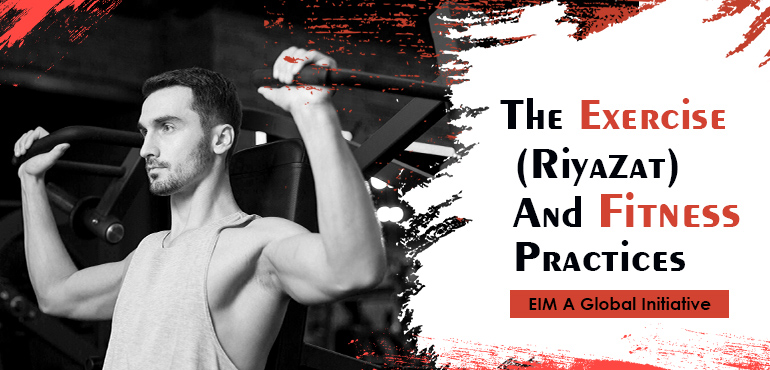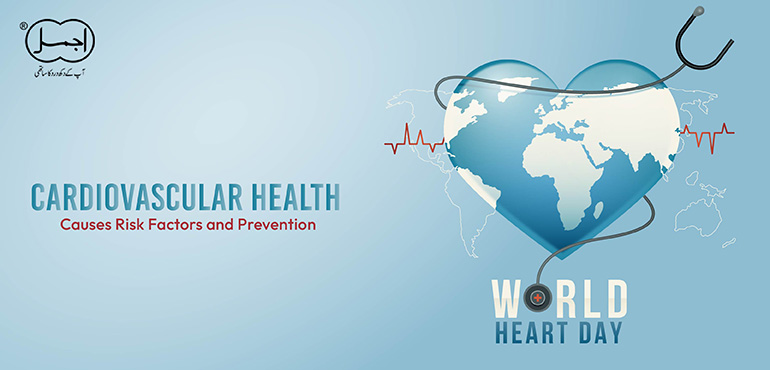Moderate exercise (Riyazat Mu‘tadila) and general fitness is actually a return to natural activity as our bodies are engineered for this purpose. It is worthwhile to quote here that exercise (Riyazat) is necessary for the well-organized body processes, physiology (Manafi‘ al-A‘da’) and biochemistry. Physical fitness and body maintenance not only assures a healthy life but also adds up a dynamic and creative intellectual activity to make you feel lively in the existing moment. That’s why we say, ‘Exercise is Medicine’.
Global EIM initiative
Keeping the substantial involvement of exercise (Riyazat) and fitness in healthy living, American College of Sports Medicine (ACSM) baking with American Medical Association and Office of Surgeon Medicine stepped forward to encourage exercise and fitness. They globally advised every concerned person to spread awareness regarding the good sides of exercise (Riyazat), especially its part in dealing with pronounced medical ailments. Therefore, ACSM assembled 11 new committees for global implementation of EIM on November 5, 2007. They quoted 407 reference in their written document for this global EIM initiative and emphasized:
“A healthy person must perform a 150 minutes dynamic exercise (Riyazat) per week at least”
It reflects the success of this EIM initiative that PubMed dispatched a list of 56,692 citations under the title ‘Exercise is Medicine’ on January 30, 2014.
EIM has Roots from Antiquity
Not less than 95 years ago, when we look back we can see Mckenzie has supported this ‘Exercise is Medicine’ concept. Even Peter Karpovich, an internationally recognized exercise physiologist and one of the originator of ACSM underpinned the importance of exercise (Riyadat) and fitness and said
“There is growing evidence on the preventive value of exercise and it is possible that in no distant future physical education will become a medicine”
Since the very beginning of man’s existence, we can catch sight of man’s quest for fitness. Fitness and exercising that has energized their desires. That’s how the overall evolution from sedentary existence in neolithic age to paleolithic age took place. In the neolithic age, man was inevitably living a nomadic lifestyle in caves or forests as hunter gatherer. But it was actually the man’s quest for fitness that was always encouraging them to survive through hunting and gathering periods and enter in a civilized era where they started living near the river banks and initiated farming and cultivation.
So, the beginning of the Paleolithic period marks life besides the banks of the Nile (Africa), Indus (Asia), Tirgus (Turkey), Euphates (Western Asia) and Yellow River (China). Among all these, People living beside the Indus Valley and Yellow River made significant contributions in polishing the civilization. As archaeological excavation on these areas has confirmed:
- These people were facing a myriad of diseases when they started living in one place.
- Second, they have developed sanitation systems which reflect their concerns for public health and life
importance of exercise (Riyazat)
In short, their search regarding human health and concerns for survival lead them towards the key role of exercise and fitness. Therefore, several philosophers, physicians, physiologists and other related persons either individually or combined followed the path enlightened by pioneers. They were familiar with the importance of exercise (Riyazat) that’s why they had made it a component of their medical theories and vitalized it in physician’s practices.
Several names must be considered here that have made remarkable work in promotion of exercise as medicine in medical practices, among them the names of philosophers and physicians from Greece must be written in golden words for their extraordinary efforts and intellectual writings.
Let’s have a look at how different ancient scientists have promoted EIM and how we can use exercise to resolve various health problems.
Some of the Glorious Names from Ancient Times
Sasruta from India (Asia)
Indo-Europeans (Aryans) gave rise to Hindu culture in India (Indus Valley). People at that time were backward. They believed that diseases spread due to some supernatural powers and demons. So, they wrote several sacred texts. From which we confer that they consider disease and health are controlled by separate gods and goddesses. In other words, the concepts of humor (body fluids) were unknown to them before the advent of humors theory by ancient Greeks.
However, Aryans composed the concept of tridosa doctrine that has significance in ancient literature of the Ayurvedic medicine system. Here Sasruta (Father of Plastic Surgery) being a supporter of tridosa doctrine played his role as a physician in the promotion of exercise (Riyazat) for fitness and maintenance. He emphasized
However, Aryans composed the concept of tridosa doctrine that has significance in ancient literature of the Ayurvedic medicine system. Here Sasruta (Father of Plastic Surgery) being a supporter of tridosa doctrine played his role as a physician in the promotion of exercise (Riyazat) for fitness and maintenance. He emphasized
“Exercise (Riyazat) is a sense of weariness from bodily labor and it should be taken every day”
Sasruta found that regular exercise boosts up the body’s energy level and prevents the pathogens from causing disease. So he promoted the association with walking, running, jumping, swimming, diving, or riding and participating in sports such as archery, wrestling, and javelin throws as forms of exercises.
During 600 BCE, Susruta was the first physician at Banaras University who prescribed different exercises to patients along with oral medicine. However, he always took into account the patient’s condition, diet, physique, age, strength and exercise terrain while suggesting any kind of exercise. He reinforced the concept of humor theory that a disease arises due to imbalance in any humor (any of 4 types of body fluids). Therefore, he recommended a set of mild exercises equivalent to only half extent to capacity.
Exercise for Obesity (Siman Mufrit) Treatment
Susruta explained obesity (Siman Mufrit) as disturbance in humor causes elevation in the lymph cycle. He coined the reason behind this ailment marked by pampering the protruding belly. He advised to break up the physical inactivity and disturbed sleeping cycles and practice light to heavy exercises.
Exercise for Diabetes Treatment
Susruta had associated obesity (Siman Mufrit) with an injudicious diet that usually came in combination with obesity (Siman Mufrit) and was incurable. He practiced several dietary changes (Dietotherapy / Ilaj Bil Ghiza) and exercises such as:
- Long walks
- Involvement in sports (Wrestling / Riding)
- Physical Activity
Pythagoras from Samos (Greece Exercise)
A great medical philosopher, former athlete, mathematician and astronomer – Pythagoras led the foundation of “Philosophical Medical College” in Corton, Italy where he practiced the regimen of exercise (Riyadat), music (Mawsqiri), diet (Ghidha) and meditation to bring inner serenity to a busy mind. He pointed to the importance of exercise to stay fit and motivated as he believed that any imbalance in elements, qualities, and tendencies of the body could disturb the harmony and mental peace, leading towards sickness.
Herodicus From Selymbria
Even though we have unfortunately lost the work of Herodicus at this time, still what we have is quite enough to give consideration to his efforts for supporting exercise. He was a sports teacher, also a former teacher of Hippocrates. He merged sports (exercise) with medicine (Mu‘alajat) and led the foundation of sports science. He proposed “Two Bodily Liquid Theory” which elaborated that:
| “When a person eats in excess and does not perform enough physical movements (exercises), the two types of body liquids produce inside the body – a sharp and a bitter. These liquids are bile and phlegm. However, the onset of an ailment depends on the dominance of any liquid (homeostatic balance) and their origin (liver, brain, spleen).” |
This theory was accepted by the locals and then, after further research, Hippocrates formulated the “Four Humors Theory” although he and some other physicians disliked his strenuous exercise methods. However, it was Herodicus who depicted the therapeutic effects of exercises in detail.
Hippocrates From Ceos (Greece)
Antiquity has been marked as a golden time period of ancient Greek history. As it has visionary figures like Hippocrates that had nourished its roots through their valuable practices and literature. Especially when we debate on exercise and fitness then how could we not give consideration to Hippocrates as he has written three extensive writings on ‘Regimen in Health’. Furthermore, he falls among the first physicians who have prescribed written exercises to his patients believing that eating alone could not deal with the ailments. Moderate exercises (Riyadat Mu‘tadila) must be employed for warming, thinning, and purging away the humor. Hippocrates believed that;
“Walking is man’s best medicine”
Moreover, he was a promoter of humor theory, initially formulated by Aristotle. That’s why he explained that diseases might arise due to humors imbalances and physical inactivity might be a cause of metabolic disorders like diabetes (ziabetus), Blood pressure (Daght al-Dam) and obesity (Siman Mufrit). He always took an account of a person’s lifestyle, personality, diet, and habits and then worked on the present ailment and told his followers and patient to do nothing as self-medication if they were not sure about results. He emphasized.
“Before you heal someone, ask him if he’s willing to give up the things that make him sick”
Then, he said:
“As to diseases, make a habit of two things — to help, or at least, to do no harm.
Also, he quoted this as:
“Primum non nocerum. (First do no harm)”
Likewise, at another place in his literature he added:
“Declare the past, diagnose the present, foretell the future”
However, he has supported walking for its multiple amazing health benefits for body and mental health. Today, all the modern physicians recommend walking 30 minutes on a daily basis. Hippocrates reflects the importance of exercise (walking) by saying this:
“If you are in a bad mood go for a walk. If you are still in a bad mood go for another walk.”
Diocles From Athens (Greece)
He was a Hippocrates pupil who directed kids to go to gym twice a day or on a daily basis promoting the influence of balanced diet, exercise and bathing on health. Likewise, he suggested moderate exercises (Riyazat Mu‘tadila) like long rapid walks for youngs and oldies to facilitate digestive activities that eliminated the risk of gastro-intestinal disorders.
Galen From Pergamon (Roman Empire)
Claudius Galen (Jalinoos) has deliberately admired the Hippocrates’ work and borrowed his concepts to demonstrate his own theory, ‘Theory of Hygiene’. In his theory he emphasized that hygiene (Ilm-i-Hifzan-iSihha) is an important potion of medicine and exercise is a vital branch of hygiene (Ilm-i-Hifzan-iSihha). Moreover, he gave the concept of naturals, non-naturals and contra-naturals.
Antiquity ends with the death of Galen but during his life, he made extraordinary contributions in serving mankind through his practice and precious teachings. During Galen’s time, the ancient Greece people were involved much in the sports and they used to do intense exercises for athletic bodies. But at that time, Galen opposed them and deliberately quoted that these intense exercises would put them in danger and whenever they stopped doing this in their old ages, they might face organ enlargement problems.
Galen’s manuscript ‘On Hygiene’, is his finest collection on health and exercise in which he has warned people about the necessity of motion (exercise) to stay at peace with different bad health conditions. Not only has he pointed this out but also defined the normal exercise (Riyadat) duration, its types, qualities, and execution places to stay fit and healthy. In another treatise, ‘The Exercise With the Small Ball’, Galen has suggested the exercise using small balls be the most effective and safer exercise for all.
Exercises Borrowed from Greeks
As we all know, Greeks were more into exercise and fitness than any other nations. They prefer sports and games not only for the well-being of their body but also for refreshing their mind and soul. So, here is a set of exercises we have borrowed from ancient Greeks that can help you make six packs by reducing excess body flesh and staying in shape.
The Tetrad by Philostratos
It involves the four day athletic training cycle by traditional Greeks in each day for specific types of activity. The athletes follow their diet, exercise and sleeping schedule to get the desired fitness outcomes.

Day 1 – Preparation Day
Day 2- All-out Trail
Day 3 – Relaxation Day
Day 4 – Medium-Hard Workout
Denouncing High-Carbs (Mawad Nasha’iyya)
Diet is a special part along with moderate exercises (Riyazat Mu‘tadila) as all of your efforts go in vain if you do not follow a diet pattern strictly. Cladius Galen has pointed this out centuries ago, when the gladiators made their bodies flabby for any combat due to excessive use of barley porridge with loaded beans.

Running in Sand (Ramli)
Greek trained their sprinters to walk on sandy areas instead of long rough tracks because it is difficult to hold grip on sandy patches. So, this practice builds up their stamina. Along with running, they made use of various obstacles to polish extra skills and abilities in the runners. They used to jump over ditches while carrying weight with them. This exercise was reported by a Mediterranean philosopher, Anacharsis in one of his manuals.

Range-of-motion Exercises | Plain Old Stretching
Egyptian civilization is the preeminent civilization in Mediterranean time. We have Egyptian paintings in its ancient old cities that were made almost 2000 years ago. They have pictures of limber citizens bending over backwards until their hands touch their toes. Such pictures reflect that these ancient folks were familiar with the type of exercise (Riyazat) to which we now call, ‘Plain old stretching’.

Moderate Exercises (Riyadat Mu‘tadila)
We have Seneca the Younger from the Roman Imperial Period. He was a physical education instructor who coined swimming, jumping, light weights lifting and other such exercises as moderate exercises (Riyazat Mu‘tadila). These exercises were relatively mild and simpler as compared to strenuous exercises prescribed by Hippocrates for his patients. They give the same results without putting any additional stress on that person. So, adopting strenuous exercise is pointless until and unless you really need to do so.

Livestock as Makeshift Dumbbells
Milo of Croton was a famous wrestler and athlete from antiquity. He was habitual of lifting young calves onto his shoulders. These habits gave strength to his shoulders to lift up a heavy bull. So, from this even from 6th century BC, we can confer that people used to employ livestock animals as makeshift dumbbells a long time ago.




